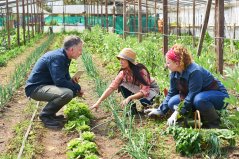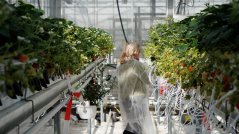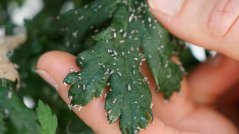
Background
The cultivation of the future requires the cross-pollination of science and practice
A canopy that can be extended and retracted like the roof of a convertible to protect apples when it rains and offer them full sunlight when the weather clears: the convertible canopy is just one of the ideas born from an exceptional collaboration between scientists, growers and policy makers.
We live in an age of transitions. In the future, we’ll switch to cleaner energy and plant-based proteins and make use of greener agriculture and horticulture practices. Transitions like these aren’t easy. They often require entirely new systems: new ways to generate energy, new protein sources, and new cultivation systems. These systems aren’t developed in isolation. Oftentimes, governments, businesses and scientists work together to bring about the necessary innovation, like they do at Wageningen University & Research (WUR).
A variety of practical experts ranging from growers to policy makers contribute their expertise over the course of the study.

Bert Lotz and his colleagues are making strides in the collaboration between science and practice. Lotz leads the team of Applied Ecology at WUR and heads the ‘Groene Gewasbescherming’ (Green Crop Protection) project, financed by the Ministry of Agriculture, Nature and Food Quality (LNV). “We are developing new cultivation systems that sustainably protect crops from disease, pests and weeds,” Lotz explains. “And we don’t just do this through innovative use of nature and technology, either. A variety of practical experts ranging from growers to policy makers contribute their expertise over the course of the study to make sure our results are ideally tailored to the future.”
Fewer crop protection products
“The project aims to significantly reduce the use of crop protection products in agriculture and horticulture by 2030,” Lotz says. This long-term perspective is one of the distinguishing features of this policy-supporting project. The switch to new ways of protecting crops against diseases and pests requires entirely new cultivation systems. “With this project, we can make great strides to enable far-reaching innovation. We aim to develop prototypes which, after further research in cooperation with the industry, can be prepared for practical application.”
With this project, we can make great strides to enable far-reaching innovation.
The close involvement of think tanks and focus groups perfectly suits this approach. Growers, researchers, practical experts and policy makers are invited to help conceptualise and test solutions. “It’s a collaboration,” Lotz stresses. “They contribute to every aspect of the solution. Engaged growers and experts learn from the project, but we also expect them to use their knowledge and experience to contribute to the project.
Practical knowledge
‘Groene Gewasbescherming’ consists of various subprojects, each focusing on a certain type of cultivation: agriculture, lily, apple and strawberry cultivation. Each project was assigned its own think tank and focus group, which could focus on a certain type of cultivation. Lotz explains how motivated the parties involved were in their contribution. “Commitment is one of the benefits of this approach. The people concerned – the growers, the companies that really need to become greener – are directly involved in the innovation process.”

Lotz remembers a moment halfway through the agriculture project. “This project eventually led to a combined package of solutions, like smart crop rotation, growing resistant varieties and implementing an edge strip with plants for insects with a pollinating and pest control role. When we looked at the financial side of things, the growers faced higher costs, while it wasn’t certain whether they could charge higher rates for their products.”
Commitment is one of the benefits of this approach.
However, the focus group showed its worth in this situation, too. Lotz describes how a member of this group, the representative of a trade organisation, took the stage and said: “Don’t worry; this isn’t a killing blow for the system. We can improve this aspect in a follow-up project.” Lotz: “This shows how everyone had faith that there were enough smart growers and producers that could improve our prototype at a later stage. They believe this cheaper, more efficient package will be a reality. For this research, it is important that the practical experts make their own estimation of this.”
The convertible canopy for apple cultivation
The so-called convertible canopy is one of the more creative solutions the project yielded. “It is a system of automatic, extensible walls and roofs surrounding an orchard. A sort of extensible greenhouse, as it were. Sensors respond to the environment: if they detect rainy weather, the system will engage. Once the weather clears, the system retracts again,” Lotz explains. The convertible cover is an answer to the various challenges the apple growing sector is facing, from fungal fruit rot due to moisture or damage due to hailstorms. On top of that, it helps reduce the use of crop protection products by up to 70%.
The think tanks and focus groups offer the freedom to consider, experiment, and leave the beaten track.
- Unfortunately, your cookie settings do not allow videos to be displayed. - check your settings
The think tanks and focus groups offer the freedom to consider, experiment and leave the beaten track. The idea for the convertible canopy was the result of a playful discussion between the researchers and the practical experts. “If you want to protect your apples against moisture, you need a canopy. At the same time, apples need sunlight to develop their appealing colour. Moreover, lack of ventilation may result in mildew. What if you had a roof that you could extend and retract at will?”
Greenhouse-grown lilies and strawberries
A smart solution was likewise needed to make the switch to biological pest control in the strawberry growing sector. In the new approach, strawberries are grown in greenhouses where pest insects are fought using other insects. “These useful predatory insects need to be able to find prey even when there are no pests,” Lotz explains. “During one of the sessions, an expert suggested creating comfortable nooks for them in the greenhouse. These nooks feature so-called ‘banker plants’, home to aphids that aren’t harmful to the crop. The predatory insects thrive on these plants. They can rest and multiply. As soon as a pest does appear, the growers have a healthy army ready for deployment.”

The lily growing sector was also looking for innovative, green solutions. The crux of conventional lily cultivation is the four-year cycle in which the bulbs are multiplied. This all happens in outdoor soil, where the bulbs are susceptible to viruses and fungi. In order to produce enough new bulbs despite these risks, the growers use insecticides and fungicides. “The think tank did see the appeal of moving bulb cultivation to greenhouses, where this process could take place safely and cleanly, without the need for crop protection products. The idea was a success. After a year in the greenhouse, the virus-free bulb can be moved to the field, where it is cultivated for another year.” Since the bulbs do not suffer from any viruses, the grower doesn’t need to use crop protection products against the insects that normally transmit those viruses.
Free, motivated engagement
In addition to their enthusiasm and creativity, the experts and policy makers involved also have a critical eye. After all, who better to assess the potential of a prototype than practical experts? “The lily project is an excellent example of the assessment function of focus groups,” Lotz explains. The bulbs grown in the greenhouse varied too much in size and shape. “We weren’t quite there yet, the growers said. Getting a result that had market potential was, after all, the real ambition of the project.”
The lily project under the umbrella of Lotz and his team will now be concluded. “But this is not the end of the ride. The idea is still alive and kicking, and we are looking for a new collaboration with the industry to continue the research. There is more to be discovered in this area.”
This way, practice and research become closely intertwined, even when it comes to bolder innovations.
When describing the atmosphere in the think tanks and focus group, Lotz keeps coming back to the word ‘necessity’. Both the scientists and the practical experts know that crop protection simply needs to become greener. There is also a clear awareness that many crop protection products will disappear in coming years. “This project invites those involved to think of ways to continue cultivating crops in the future, in a confidential, safe atmosphere. And they certainly make use of this. In almost every project, scientists find that, though they themselves remain cautious, growers and policy makers say: we’re running out of time – keep going!”
This way, practice and research become closely intertwined, even when it comes to bolder innovations. “This form of research offers perspective for the future. That perspective frees us from the issues of the day and motivates us to truly work towards innovation.”